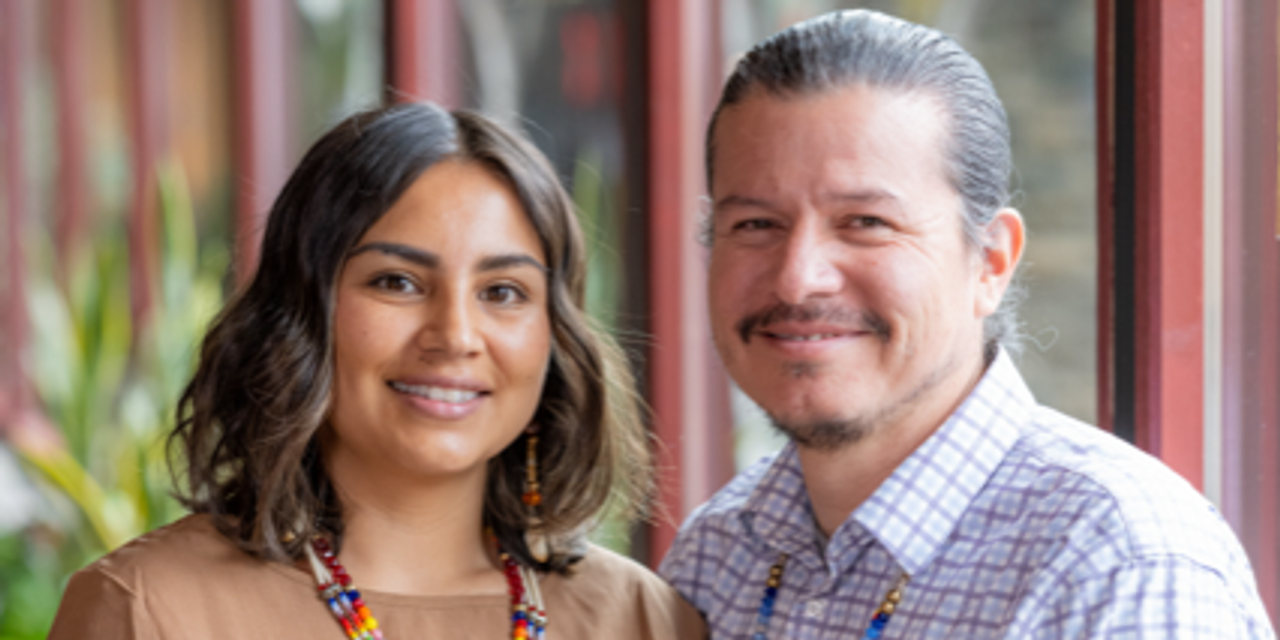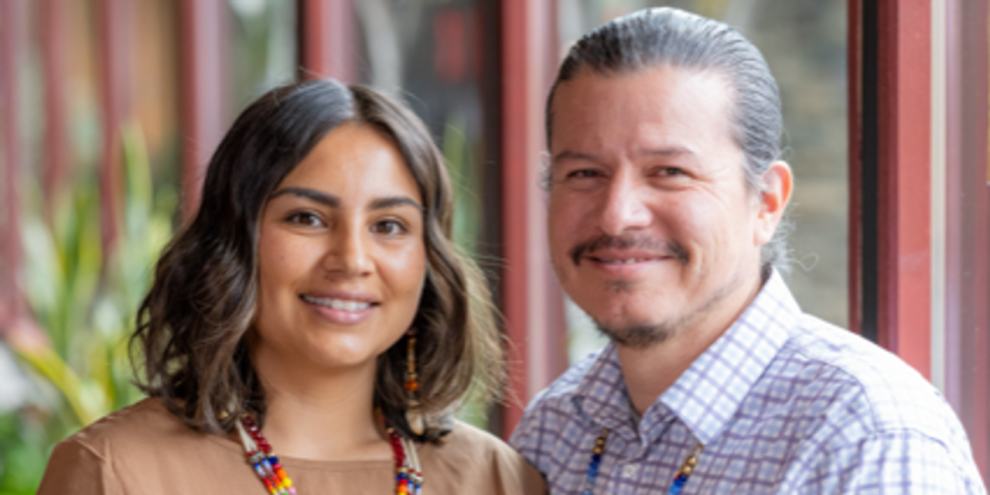
Sammy Matsaw knows all about isolation in the digital era.
Matsaw, 46, was about to graduate with a Ph.D. in water resources when the coronavirus pandemic hit in March 2020. A member of the Shoshone-Bannock Tribes, Matsaw lives with his wife, Jessica Matsaw, 35, and their four children in a three-bedroom house on the Fort Hall Reservation in southeastern Idaho.
The family did not have broadband access, he told MarketWatch, so he had to prioritize his family’s needs and ration out the household’s mobile data among all members of the family. The university, which was a nine-hour drive away, postponed Matsaw’s Ph.D. graduation as he couldn’t go in person.
Jessica, a master’s student in education, was teaching high-school students on the reservation through an unpaid internship. Teaching went online, but because most students on the reservation were also cut off from internet access, she ended up making one-on-one student visits.
“To ration out their data, kids’ schoolwork came first. The Matsaws worked around their schedule to squeeze in meetings. But a week into the monthly plan, their high-speed data ran out. ”
Early on, the household of six relied on two mobile-data plans — Matsaw’s and Jessica’s — for all remote needs. That included the kids’ school, Jessica’s teaching, Matsaw’s university meetings for his thesis, and all family appointments.
To ration out the data, their kids’ schoolwork came first. The Matsaws worked around their schedule to squeeze in their meetings in the early morning and evening. Sometimes, when the connection was spotty, their lines would drop in the middle of a class or Zoom ZM, +1.28% meeting. A week into the monthly plan, their high-speed data ran out.
“We were basically relying on cell service, and the cell service out here is not very great,” Matsaw said. “We’re lucky to have 3G or LTE. There’s no 5G here.”
With a difficult schedule and their internet crashing, Matsaw — who is currently working as a research scientist for Shoshone-Bannock Tribes’ Fish and Wildlife Department in Fort Hall, Idaho — said he and his wife were opting out of most of their virtual meetings.
Matsaw found himself constantly asking, “Do we have to meet? Do we need to? Is it necessary?”
Often, the answer was unavoidable: “It’s like, ‘Well, we just can’t meet. The best I can do is email you, and that’s just gonna have to do’,” Matsaw said.
Native Americans and broadband access
This is not an uncommon problem, Matsaw said, especially among Native Americans living on reservations.
Recent research also highlights what has become a persistent problem. “Native American communities are underserved by broadband internet providers,” according to a report by the Brookings Institution, a think tank based in Washington, D.C.
“[E]ven with an array of federal programs designed to support broadband access in these places, the lack of density on many reservations — rural ones in particular — makes broadband prohibitively expensive,” the report added.
The reasons behind this are multifold, mostly due to job distribution, a lack of broadband access and a home office, according to the research by Matthew Gregg, a senior economist at the Federal Reserve’s Center for Indian Country Development at the Minneapolis Fed, and Robert Maxim, a senior research associate at Brookings Metro.
“While the CARES Act and the Infrastructure Investment and Jobs Act have provisions to expand broadband access in rural Native communities, the amount of investment needed is so large that these bills alone aren’t enough to solve the problem,” Gregg and Maxim wrote.
“Moreover, some Native American households may lack a computer, relying instead on mobile devices to access the internet, which greatly limits their ability to work remotely,” they added.
“‘Some Native American households may lack a computer, relying instead on mobile devices to access the internet, which greatly limits their ability to work remotely.’”
Black and Latino workers have also been less likely than their white counterparts to have access to remote work during the pandemic, and are less likely to have home broadband access. But Native American communities face some unique challenges.
Around 19.6% of American Indian and Alaska Native workers reported working from home for at least some of the previous four weeks in the summer of 2020, during the height of the COVID-19 pandemic, the Brookings researchers found.
That’s compared to the 49% of Asian employees who worked remotely in June 2020, 31% of white workers, 26% of Black workers and 21% of Hispanic workers, according to the Bureau of Labor Statistics. Overall, about one-third of American workers worked from home during that time.
American Indian and Alaska Native workers are overrepresented in so-called low-skilled and often lower-paid occupations, and underrepresented in high-skilled and higher-paid occupations such as management and professional occupations, a separate Minneapolis Fed paper shows.
What’s more, American Indian and Alaska Native workers had the highest unemployment rate among all groups, at 28.6% in April 2020, according to the Bureau of Labor Statistics. The national unemployment rate that month was 14.7%, with the unemployment rate for Black workers at 16.7%, and Hispanic and Latino workers at 18.9%.
A bigger infrastructure access gap
As the job market and economy have improved, the gap in remote work between white workers and Native American workers has narrowed, but still persists. By early summer of this year, the gap had narrowed to 2 percentage points, according to the paper by Gregg and Maxim.
The share of households with internet access is around 20 percentage points lower in tribal areas than in the rest of the country: Some 58% of households on reservations have broadband, compared to 78% of the overall population, according to the Minneapolis Fed.
The access gap between tribal and non-tribal areas is approximately three times larger than the Black-white access gap, and about four times higher than the urban-rural one, research shows.
“Some 58% of households on reservations have broadband, compared to 78% of the overall population, according to data from the Minneapolis Fed. ”
At the same time, many Native American workers living on reservations find it hard to find a home-office area, as many homes are crowded, Gregg said. While many tribal communities have multigenerational households, they also face unique housing difficulties, Gregg told MarketWatch.
“Essentially on reservations, we see very few homes, in part because it’s really hard to access the credit to build a house,” Gregg said.
Matsaw’s family moved back to the reservation in 2019, where they had a home, due to the high costs of living in the city near the university. When the pandemic began in early 2020, Matsaw’s brother was also staying with the family while he worked as a substitute teacher. The three-bedroom home hosted all the online meetings for three adults and four schoolchildren.
The family’s internet situation improved after Matsaw asked the telecommunication company to connect their lines to an internet tower off the reservation.
Still, “we were all in each other’s space,” Matsaw said.
It’s an ongoing struggle for his family, as they navigate how to work and study in a 1,200-square-foot space. Last Sunday, he stayed in the back part of the house while the rest of the family stayed in the front, so he could attend an online meeting.
“Families are on top of one another,” Matsaw said.
Remote work in the community
Opportunities for remote and/or hybrid work can help with the economic development of reservations and improve the brain drain the community faces, Gregg told MarketWatch.
“Historically, there’s been a lot of brain drain. Most skilled workers are leaving reservations because there’s a greater return for their skills off of the reservations,” Gregg added. More hybrid work could help mitigate the migration, and retain that talent in their native homeland, he added.
The decision to stay or go can have big consequences when it comes to job opportunities. American Indian tribes “invest millions of dollars in educating their members only to have little return on their investment,” according to a 2017 paper published in the International Indigenous Policy Journal. The paper concluded that “constant, lengthy, and meaningful relationships were motivating factors in drawing participants back to contribute to their reservations.”
For indigenous workers with a higher education, finding and maintaining those networking opportunities can be hard, Matsaw told MarketWatch. Remote-working opportunities are few and far between, especially if people hope to stay close to their home community, he added.
“‘I get to be here, be involved in culture, be involved with family, be involved in everything, from funerals to the Sun Dance ceremony during the summer and everything in between.’”
“The role of employment discrimination can’t be discounted when considering Native Americans’ access to jobs that allow for remote work,” Greg and Maxim wrote in their paper.
“Multiple scholars have found that even when controlling for educational disparities, Native Americans still tend to end up in jobs that require less education and have worse labor market outcomes — with the effects of the latter being particularly strong in states where Native Americans make up a larger share of the population,” they added.
This summer, Arizona State University hired a Native American faculty member in a remote position, where the faculty member can research and teach from their home community.
Desi Small-Rodriguez, a Cheyenne-Chicana professor of sociology at the University of California, Los Angeles, tweeted TWTR, -4.86% that it would be a game changer if more universities allowed that.
“This hits hard today as I leave my reservation back to LA for the academic year. Leaving behind not only relatives but critical opportunities for research & teaching in the places & spaces where tribal sovereignty remains, where Natives are majority, where we are not invisible,” she tweeted.
Matsaw chose the other route. After graduating in 2021, he worked with his Native American community to apply his Ph.D to relevant jobs in his community, which he described as “really difficult.” Having advanced degrees is still uncommon on reservations, including in management roles, he added.
Some 8.6% of Native Americans and Alaska Natives on Fort Hall Reservation held a bachelor’s degree or higher last year, according to the Minneapolis Federal Reserve, compared to 37.9% of all U.S. adults aged 25 or higher, per separate data from the Census Bureau.
As a result, Matsaw has less pay and less responsibility. “I have less ability to really exercise the skill set that I have. It’s this give and take because of these trade-offs living in my community,” he said.
“I get to access my community, I get to be here, be involved in culture, be involved with family, be involved in everything, from funerals to the Sun Dance ceremony during the summer and everything in between.”
“That’s my sacrifice,” he said. “It is being able to be here, but not be in a position that I would ideally like to be in, and that I’m educated for.”






